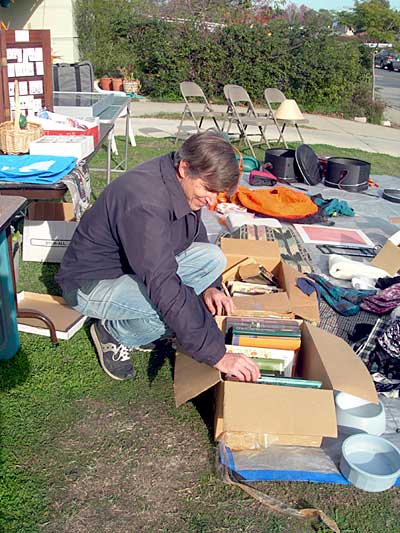
 |
|
|
|
Recycling alone is not the answer
December 2008  Shopping at yard sales not only saves money, it helps the environment. Photo by Debbie Bulger. by Virginia Draper By 2000, most California communities diverted at least 50% of solid waste from landfills, a goal mandated in 1989 by AB 939. But we need to do much better than that. To figure out where to focus public outreach, in 2007 the California Integrated Waste Management Board commissioned a survey of residents’ attitudes towards waste management and their habits regarding reducing, reusing, and recycling, the 3Rs of Zero Waste. The survey results suggest that the public may not understand the concern about landfills. When asked about environmental priorities, less than one in five identified landfill waste, toxic waste, or the extinction of plants and animals as concerns. Nevertheless, the majority surveyed regularly recycle key household items, though only one quarter are recycling as much as they could, and few are regularly recycling plastic bags. Respondents were far less knowledgeable about ways to reuse and reduce: “Only about one-third of California residents regularly reuse food containers or drink water from sources other than small plastic water bottles. Less than one-in-five consistently buy products in bulk or items with less packaging.” Fewer than 10% compost. Thus the first recommendation of the report is “to increase efforts to promote waste reduction and reuse, which lag behind recycling in public awareness and practice.” Angela Brantley, Solid Waste Program Manager for the City of Monterey, welcomes this focus: “We know that recycling alone is not the answer.” Brantley works with Monterey businesses to develop reuse practices. For instance, she suggests setting aside office space where employees can put items they no longer use, but that others may want. And she makes sure everyone is aware of the Last Chance Mercantile in nearby Marina, a reuse depot operated by the Monterey Regional Waste Management District. Here people can leave and buy at “affordable prices” things that might otherwise go into the landfill, such as sporting goods, furniture, automotive parts, and accessories. In Santa Cruz County at the Buena Vista Landfill and Ben Lomond Transfer Station, a program run by Kasey Kolassa, manager of the county’s Recycling and Solid Waste Services, gives away materials dropped off from construction and demolition projects. Residents can also pick up free household paint which, according to Kolassa, makes up more than 80% of the hazardous waste brought in. The recent decline in commodity prices for recycled paper, metals, and plastic heightens the need to encourage people to choose reusable and secondhand items rather than those that can be recycled, especially plastics. Most plastics end up in the landfill after one cycle because they can be turned into only one other product.
Some find ways to reuse materials closer to home, rather than ship them to China or out of state. The Grey Bears, a Santa Cruz nonprofit, sells rolled newspapers to local floral industries for shipping insulation. They also refurbish computers and other goods for sale in their Santa Cruz Thrift Store. In addition to reuse, the California Waste Management Board survey raised concerns about the disposal of hazardous wastes. The Board is asking local agencies to increase public awareness about what constitutes household hazardous waste, to provide more convenient disposal sites, and to better inform the public about when and where residents can drop off materials. A final recommendation of the survey urges local entities to “continue to support efforts to make recycling services available to multi-family households.” To address this challenge, Brantley said that her agency in Monterey has recently received two large grants from the California Department of Conservation, one focused on low-income housing. In 2007, the City of Monterey kept 67% of the waste generated out of the landfill. Manager Kolassa estimates Santa Cruz County kept 65% out. Both want to do much better. The Waste Management Board survey suggests that to increase percentages, these agencies need to educate people about the limits and dangers of landfills and to provide more information and encouragement, especially about ways to reuse products and reduce waste overall. In November former State Assemblymember John Laird and former State Senator Sheila Kuehl were appointed to the California Integrated Waste Management Board. Both Laird and Kuehl have been honored as Recycling Legislators of the Year by Californians Against Waste. |
|